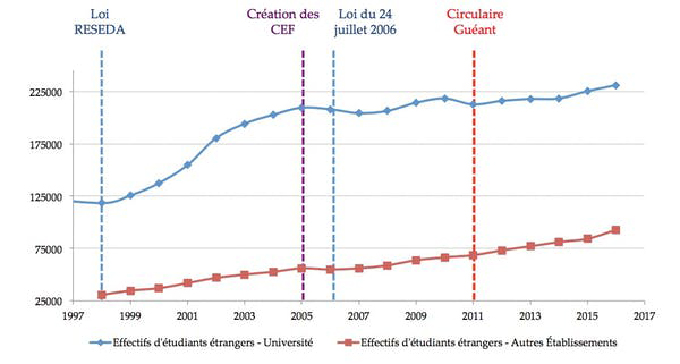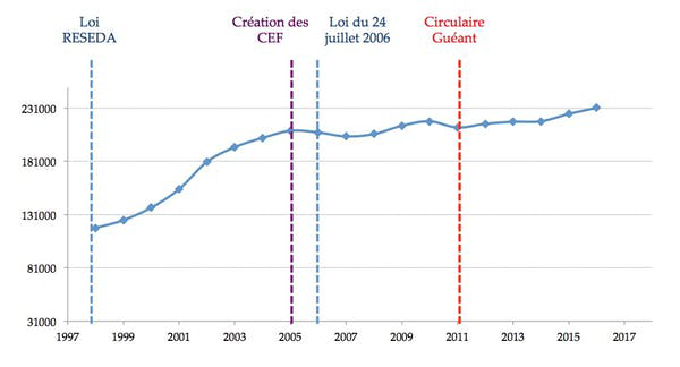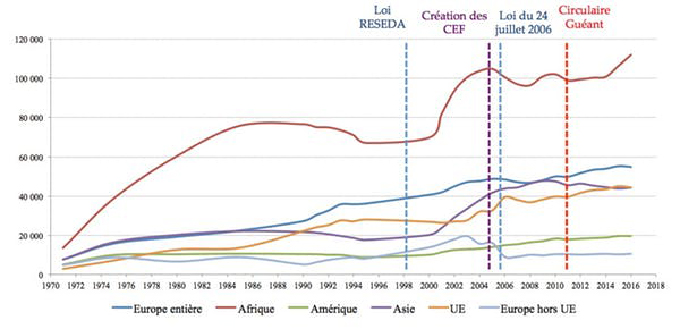
The “attractiveness strategy for international students” presented by Édouard Philippe on November 19, 2018 has aroused a lot of reactions in academia and associations, rightly so. The Prime Minister claims to “win the battle of international competition between our higher education and research systems” by sharply raising tuition fees for students outside the European Union in order to accommodate “the brightest and brightest students.” the most deserving.
This is to forget that one of the reasons that allow France to position itself among the most popular destinations of international students is precisely the near-free of its educational system. As a continuation of the policy of “chosen immigration” adopted under the Sarkozy government, the current reform risks accelerating a selection already based on the potential economic contribution of these students, as perceived by the ruling class, and therefore to reconfigure the characteristics of student mobility to France.
A turning point in 2006
This reversal comes after two decades of strong growth in the number of foreign students enrolled in higher education, encouraged by the relaxation of reception conditions on French soil with, for example, the facilitation of obtaining the visa decided in 1998 by the Jospin government ( RESEDA law ). Added to this was the obligation to justify refusals of visas against students as well as the increase in French government scholarships.

Number of foreign students in universities and other institutions of higher education (1998-2016). MESRI / SISE , Author provided
In the 2000s, a comprehensive reform of the immigration policy is undertaken, firstly with the law of 26 November 2003 , on the fight against illegal immigration, then that of 2006 which aims to better select migrants according to the economic needs of France, and thus to “promote a chosen immigration and successful integration”.
Various measures are intended to facilitate the entry and stay in France of students and researchers, preferably those who respond to the Sarkozy’s vision of the “good migrant”. It is within this framework that the government will set up, in 2005, the Centers for Studies in France (which will later become Campus France ). The drop in flows between 2005 and 2007 may be due to the introduction of these CEFs which would have increased the selection, particularly on the basis of social origin, as shown by the works of Alexis Spire .
The 2011 Gueant Circular
The series of restrictive measures continues in 2011 with the introduction of the highly publicized Circular Guéant Circular 2011 , which limits the possibility for foreign students graduates to work in France. This had a very punctual effect: the number of first residence permits granted to students dropped from 64,928 titles in 2011 to 58,857 in 2012. A drop that mainly affects students from African countries.
This circular thus not only restricted the possibilities of stay in France, but also sent a negative signal to the candidates at departure. On the other hand, its impact will be reduced very quickly, as soon as it is repealed the following year under the pressure of academics and student associations. The number of foreign students enrolled in higher education institutions in France will continue to grow from that time.
But what about the composition of these migrations? This issue is more complex, especially since data on the social origin of foreign students are not available at the national level. We try to give some answers and see first of all that the flows are redistributed between the types of institutions of higher education.
Attract foreign students in selective courses
While the 1998 law has had an impact on the growth of the number of students in the universities, the so-called immigration policy will mainly encourage the enrollment of foreign students in the grandes écoles or selective programs such as the preparatory classes. and IUTs. Their number is increasing steadily until 2016, and the proportion of these students has increased from 22% to 29% over this period.

Number of foreign students in universities and other institutions of higher education (1998-2016). MESRI / SISE , Author provided
This approach also favors certain disciplines, such as science, engineering, law, economics and management to the detriment of the humanities and social sciences. While there has been a significant increase in students enrolled in science since 2005, the upward trend in enrollment in the social sciences and humanities is dropping.
Rise of Asia and America
This policy is also intended to attract more and more students from developed or emerging countries – such as China, Brazil or Russia – and to discourage migration from former colonies. In fact, enrollments by major region of origin show a strong increase in the number of students from Asia, America and the European Union from the 2000s. On the other hand, if the number of students African students increase sharply between 2000 and 2005, the figures drop from the implementation of the law of 2006 until 2014.

Distribution of foreign students by continent of origin in universities (1970-2017). MESRI / SISE , Author provided
These data mask national specificities, notably the impressive increase in the number of Chinese students registered in France since 2000 (2,563 in 2000 against more than 21,000 in 2009), reaching in 2007 the same number as Algerian and Moroccan students, of which the numbers decrease over this period. The most recent years, however, show a reversal of these trends. The trends for countries with smaller numbers are less visible, but there is still a steady increase in the number of Brazilian and Russian students over the period.
A logic of “market”
The way in which student migration is managed in France comes in the context of the evolution of North-South relations and the qualitative and quantitative changes in immigration. If, at the turn of the 1960s, France adopted a very positive vision of student migration from Third World countries and greatly contributed to the training of the future elites of the newly independent countries, as early as the 1980s, the training of students foreigners is part of an international competition for “talent” and is defined in terms of “market to win”. As Borgogno and Streiff-Fénart write , the stakes of international cooperation are now
“To push French universities to hold their place in training in advanced technologies. The index of attractiveness of a university is now measured by its “technological” influence and its ability to attract students from countries where the technological level is equal to or higher than that of France.
Previous governments have thus paved the way for the current reforms. The increase in tuition fees for non-EU foreign students will have the main effect of accelerating already well-established trends leading to the reconfiguration of the characteristics of student mobility to France, unless a widespread mobilization of the university and university sector. more generally, the whole of French society can not counter these reforms.
Author Bios: Lama Kabbanji is a Researcher at the Institute for Research for Development (IRD) and Sorana Toma is a Teacher-researcher, ENSAE ParisTech at Paris-Saclay University